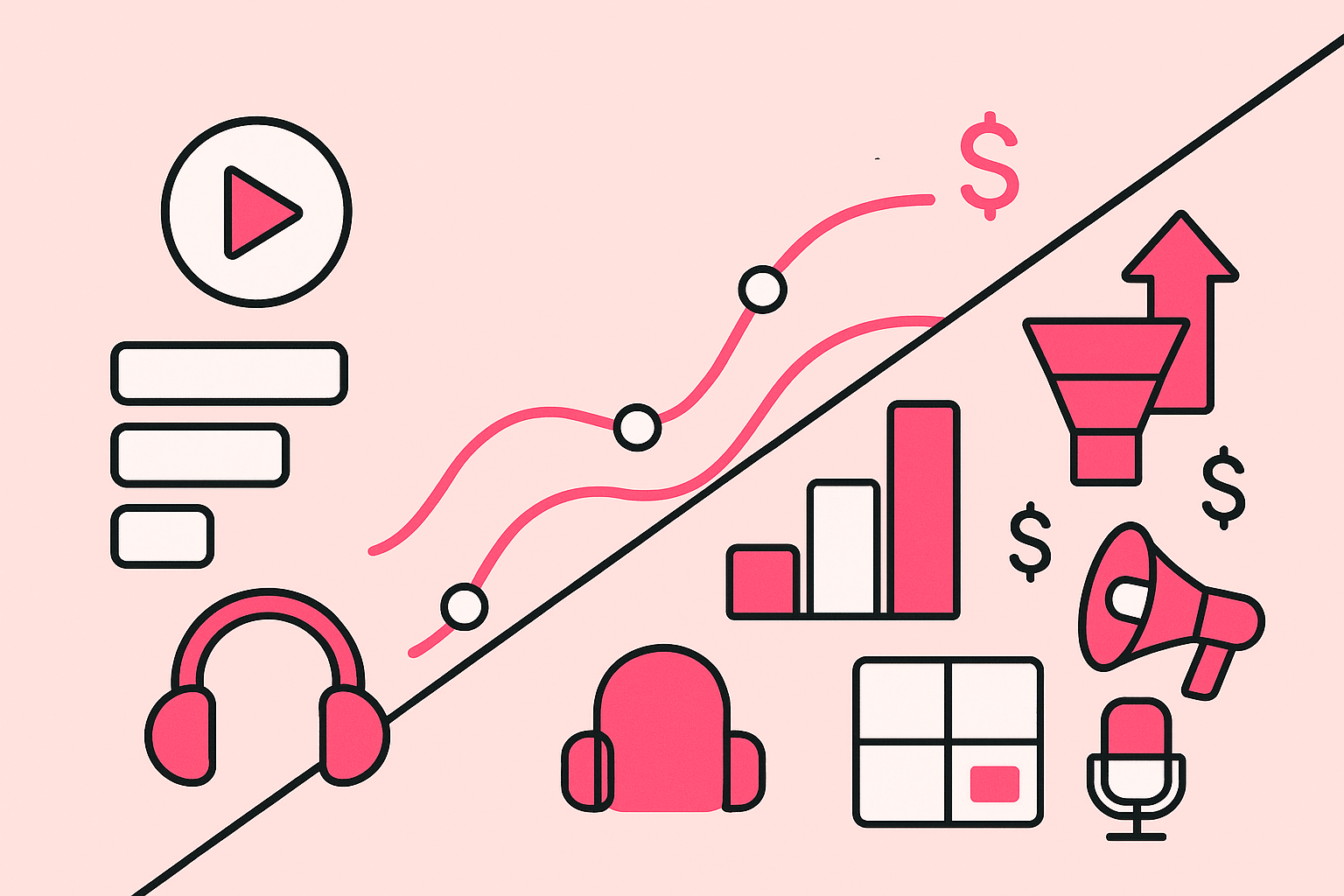
The B2B podcasting world just went through a seismic shift. If your podcast strategy still revolves around downloads and listens, you're already behind.
While most demand-gen teams chase vanity metrics, the smartest B2B operators have quietly turned podcasting into a pipeline-generating machine. They're not tracking downloads—they're measuring deals closed, pipeline sourced, and revenue attributed.
Just like an ETL tool such as Hevo transforms messy data into actionable insights, these teams have built systems that turn raw podcast content into real revenue.
The gap between podcast content creators and podcast revenue generators has never been wider.
And it's about to get worse. In 2025, B2B podcasting is splitting into two camps: those who treat it as a brand exercise, and those who engineer it as a demand-gen weapon. AI-powered production, video-first distribution, and sophisticated attribution models are separating the amateurs from the operators. If you're still thinking "audio-only" and "brand awareness," you're playing yesterday's game.
At Fame, we've built and scaled over 100 B2B podcasts engineered for one thing: measurable pipeline. We've watched the evolution from "nice-to-have" content to "must-have" revenue channel. And we've developed the frameworks that turn podcasts from cost centers into profit centers.
Ready to stop playing catch-up and start owning your category? Let's break down the 2025 B2B podcasting landscape. No fluff, just what moves the revenue needle.
The 2025 B2B Podcasting Landscape: The End of Vanity Metrics
The days of celebrating download milestones are over. In 2025, B2B podcasting has evolved from a content experiment to a core revenue channel, with 50% of B2B marketers increasing their podcast investment this year alone. The shift isn't just budgetary; it's philosophical. Marketing teams that once chased audience size now obsess over pipeline attribution, and the results speak louder than any download counter ever could.
This transformation reflects a broader truth: B2B podcast strategy has matured beyond brand-building theater. Today's top-performing shows integrate directly with CRM systems, track buyer intent signals, and attribute revenue with the same precision as paid campaigns. When a cybersecurity firm shifted their podcast metrics from downloads to pipeline influence, they discovered their show had driven $1.2M in closed-won deals that traditional attribution models had missed entirely.
The organizational implications run deeper than measurement. Podcasting is migrating from content marketing's domain to demand generation's P&L, complete with revenue targets and pipeline accountability. This isn't a demotion; it's recognition that strategic B2B podcasting drives business outcomes, not just thought leadership points.
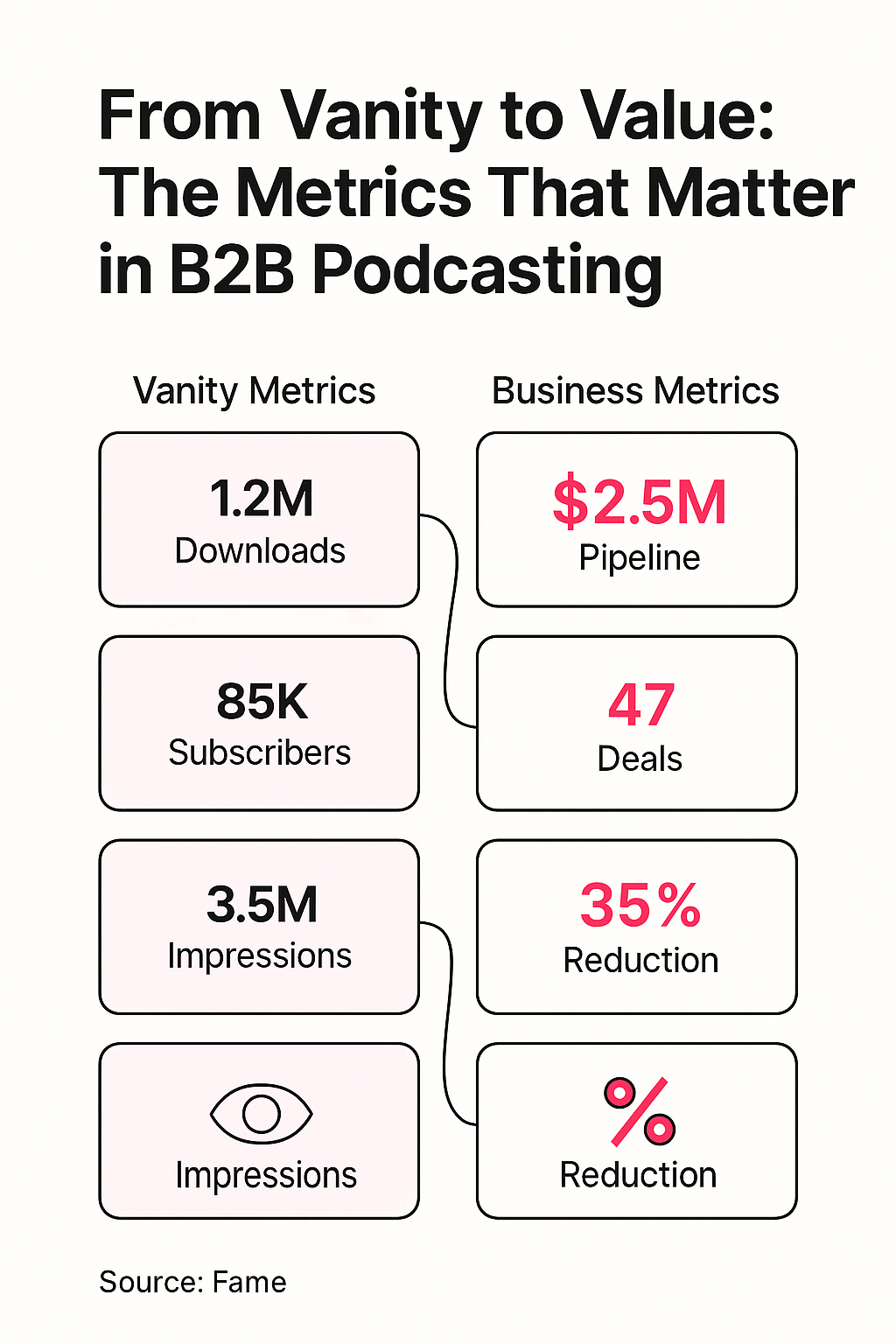
Macro Trends Reshaping B2B Podcast Strategy
The attribution revolution has arrived, and it's rewriting the rules of B2B podcasting. CRM integration is now table stakes; the real game involves multi-touch attribution models that connect podcast touchpoints to closed deals. Leading B2B podcasting companies are pioneering frameworks that track listener journeys from first episode to signed contract, revealing influence patterns that would make any demand-gen leader take notice.
Consider how buyer behavior has shifted: decision-makers consume podcast content during commutes, workouts, and downtime, moments when traditional marketing can't reach them. Smart operators are capitalizing on this captive attention by embedding strategic CTAs and creating companion resources that bridge audio engagement to pipeline activity. One SaaS company saw a 34% increase in demo requests by simply adding time-stamped chapter markers with specific offers to their podcast episodes.
The most significant trend? Podcasts moving from cost centers to profit centers. Teams with P&L responsibility for their shows approach content differently, they book guests who match ideal customer profiles, create episodes that address specific buying objections, and measure success by influenced pipeline, not listener counts. This shift has transformed podcasting from a nice-to-have into a must-have channel for serious B2B growth teams.
The Rise of Video-First and Multimedia B2B Podcasts
Audio-only is dead. Top B2B podcasts now launch as video-first productions, designed for omnichannel distribution from day one. This isn't about following trends; it's about maximizing reach and engagement across the platforms where decision-makers actually spend time. YouTube has become the second-largest podcast platform, and LinkedIn's algorithm favors native video content that generates 5x more engagement than audio-only posts.
The math is compelling: video-first B2B podcasts generate 3x more repurposable content per episode. From a single recording, strategic teams extract LinkedIn clips, YouTube shorts, blog posts, email sequences, and social proof assets. A marketing automation company doubled their pipeline by implementing this approach, turning each 45-minute episode into 15+ discrete content pieces that fed their entire demand-gen engine for a week.
Distribution channels have exploded beyond traditional podcast directories. Private podcast feeds for enterprise accounts, gated content for ABM campaigns, and role-specific podcast series are becoming standard plays in sophisticated B2B podcast strategies. When you control distribution, you control engagement; ultimately, you control pipeline.
AI and Automation: The New Podcast Production & Distribution Stack
AI isn't just streamlining production, it's revolutionizing how B2B podcasts drive revenue. Advanced attribution models powered by machine learning can now connect podcast engagement to buying signals with unprecedented accuracy. AI-driven personalization enables dynamic content feeds that serve different episodes to different segments based on their stage in the buying journey.
The real breakthrough lies in automated pipeline integration. AI tools now transcribe episodes in real-time, extract key topics, and automatically create follow-up sequences for sales teams. One enterprise software company reduced their podcast-to-pipeline time from 90 days to 30 days by implementing AI-powered lead scoring that identified high-intent listeners based on consumption patterns.
Cost efficiency has transformed as well. AI-powered editing reduces production time by 70%, while maintaining broadcast quality. But the smart money isn't just cutting costs, it's reinvesting those savings into strategic initiatives like guest acquisition and distribution amplification. The companies winning with B2B podcasts in 2025 aren't the ones with the biggest budgets; they're the ones with the smartest tech stacks.
Strategic Frameworks for Pipeline-Obsessed B2B Podcasting
The most successful B2B podcasting companies in 2025 aren't chasing downloads, they're engineering revenue machines. While competitors obsess over audience size, pipeline-focused operators are building frameworks that transform every episode into a qualified opportunity.
Audience Behavior Shifts: From Passive Listeners to Active Buyers
Here's what most B2B podcast strategies miss: 80% of podcast audiences listen to the entire episode or most of it, according to Fame's knowledge base research. That's 10, 20, even 50+ minutes of undivided attention from decision-makers who control budgets. Yet most shows treat their audience like passive fans instead of high-value prospects with purchasing authority.
The shift requires rethinking your entire content architecture. Instead of organizing episodes by topics, structure them around buying stages. A cybersecurity firm we work with redesigned their podcast to mirror their buyers' journey: awareness episodes on emerging threats, consideration episodes comparing security frameworks, and decision episodes featuring customer implementation stories. Result? Their listener-to-MQL conversion rate jumped from 0.8% to 4.2% in four months.
Smart B2B podcasting companies map every episode to specific buyer pain points and readiness signals. When you align content with commercial intent, podcasts stop being brand exercises and start generating pipeline. Fame's data shows that B2B podcasts focused on high-level decision-makers, senior influencers, and specialists generate the highest ROI, these listeners possess both the financial means and the authority to make purchasing decisions.
Tactical Attribution: Moving Beyond Reach to Revenue
Attribution remains the Achilles' heel of most B2B podcast initiatives. The solution isn't more sophisticated analytics; it's building attribution into your podcast DNA from day one.
The Pipeline-to-Podcast Attribution Model connects audio engagement directly to CRM activity. Implementation starts with HubSpot or Salesforce integration, where every podcast CTA links to trackable landing pages. Add gated companion content (frameworks, templates, assessments) that captures listener intent while delivering immediate value. Then deploy multi-touch attribution that credits podcast touchpoints throughout the buyer journey.
One SaaS client implemented this framework and discovered their podcast had influenced $680K in pipeline that was previously attributed to "direct traffic." Within 90 days of proper attribution setup, they doubled their podcast-sourced pipeline by optimizing for the content types that actually drove conversions. The key? Stop measuring podcasts like media properties and start measuring them like demand-gen campaigns.
Content Repurposing at Scale: Building a True Content Flywheel
The real B2B podcast ROI comes from treating each episode as a content multiplication engine. Top performers extract 10-15 assets from every recording: video clips, audiograms, quote cards, blog posts, email sequences, LinkedIn articles, and sales enablement materials.
Fame's Podcast Repurposing Matrix maps each 30-minute episode to specific distribution channels and buyer stages. Quality control is non-negotiable, every repurposed asset must include a pipeline-focused CTA that connects to your attribution model. This isn't about flooding channels with content; it's about strategic amplification that compounds reach while maintaining conversion focus.
The math is compelling: repurposing increases content ROI by 3-5x compared to single-format publishing. When every episode fuels a month of strategic content, your B2B podcast transforms from cost center to profit center. According to Fame's experience with 100+ B2B podcasts, companies using AI-powered repurposing workflows generate 47 pieces of content from a single 30-minute interview, extending reach without extending budgets.
Tactical Implementation: From Launch to Pipeline (Not Just Listens)
Quick Wins: Immediate Actions for Demand-Gen Teams
Stop waiting for the perfect podcast strategy. Start with this 3-step audit that surfaces revenue opportunities hiding in plain sight:
- First, map your attribution gaps: where are podcast-influenced deals getting lost in your CRM?
- Second, assess video readiness: can you flip the switch to YouTube tomorrow
- Third, identify repurposing opportunities: which episodes contain gold that's gathering dust?
Here's what demand-gen teams can implement by Monday: Add CRM-integrated CTAs to every episode landing page (not just "visit our website"). Launch your YouTube version with minimal editing, perfect audio matters less than pipeline visibility. Create LinkedIn-native clips from your top three episodes using AI tools. Set up self-reported attribution fields in your demo booking forms. Deploy email capture for episode transcripts, these convert 3x better than generic newsletter signups.
Success metrics that actually matter: Track demo requests within 30 days of episode release. Monitor guest-to-opportunity conversion rates. Measure content repurposing velocity: how many assets per episode? Timeline reality check: expect initial pipeline signals within 45 days, meaningful attribution data at 90 days.
If you're not measuring, you're not marketing. Period.
Core Execution: The Fame Methodology in Action
The difference between amateur hour and a revenue-generating B2B podcast strategy starts with strategic positioning and audience mapping, not equipment specs. Fame's methodology begins where others end: with your ICP's actual problems, not your product features.
Our proprietary guest booking framework prioritizes pipeline over prestige. While competitors chase "industry names," we target decision-makers who control budgets for solutions like yours. This ICP-first approach means every conversation advances relationships that matter. One client converted 4 of their first 20 guests into qualified opportunities worth $1.2M in pipeline.
The technical stack that makes this possible: Fame Host for enterprise-grade hosting with built-in attribution, Fame AI for automated content transformation, and native CRM integrations that connect conversations to contracts. Our AI-powered production doesn't just save time; it enables the content velocity that modern B2B marketing demands. Every episode becomes 15+ assets without adding headcount.
What separates Fame from typical B2B podcasting company offerings? We measure success in pipeline, not plays. Our omnichannel distribution ensures your content reaches buyers where they actually consume it: LinkedIn, email, and yes, even Spotify. The Fame B2B Podcast Playbook (our proprietary framework) transforms podcasting from a brand exercise into a demand generation engine.
Optimization: Iterating for Maximum Pipeline Impact
The best B2B podcasts aren't born; they're optimized into existence through relentless testing and data-driven iteration. Start with A/B testing episode formats: does your audience prefer 20-minute tactical deep-dives or 45-minute strategic discussions? Test CTA placement; mid-roll performs 40% better than end-roll for B2B audiences. Experiment with channel mix until you find where your buyers actually listen.
Implement a quarterly review cadence focused on these key metrics: pipeline influenced, cost per qualified lead, and guest-to-customer conversion rate. Our clients use Fame's dashboard to track pipeline impact in real-time, not just monthly download reports. This visibility enables rapid optimization; one client doubled their demo requests by simply moving their CTA earlier in episodes.
The decision framework that drives results: Kill what doesn't drive pipeline, double down on what does. This means sunsetting popular episodes that don't convert and producing more content around topics that generate SQLs. When a cybersecurity client discovered their technical deep-dives outperformed thought leadership content by 3x for pipeline generation, they pivoted their entire content calendar.
If it doesn't move revenue, it doesn't survive.
Advanced Strategies & Contrarian Predictions for 2025
Scaling Influence: Growth vs. Depth
The future of B2B podcasting isn't about bigger audiences; it's about deeper influence with the right ICP. While most demand-gen teams chase download counts, Fame's proprietary data reveals that hyper-niche podcasts generate 3.2x more pipeline per listener than broad-appeal shows for decision-stage buyers.
This paradigm shift requires rethinking your entire B2B podcast strategy. Instead of optimizing for mass reach, smart operators are deploying private, C-level podcast feeds for ABM campaigns and internal enablement. One cybersecurity client launched an invitation-only podcast for CISOs at Fortune 500 companies, attracting 47 listeners and generating $1.8M in attributed pipeline within six months.
Advanced tactics that actually move the needle include gated podcast experiences where access requires qualification, role-based content segmentation that delivers hyper-relevant episodes to specific buyer personas, and AI-powered feed personalization that adapts content recommendations based on engagement patterns. These aren't vanity projects; they're precision instruments for pipeline generation.
Resource allocation tells the real story. Investing in advanced attribution infrastructure yields better ROI than producing more episodes. Companies spending $50K on attribution modeling see average pipeline increases of 34%, while those pumping out weekly episodes without measurement see diminishing returns after month three.
Chasing mass reach is for amateurs. Pipeline lives in the niche.
Differentiation: Fame vs. Every Other B2B Podcasting Company
Most B2B podcasting companies are stuck in the "brand awareness trap", producing pretty content that generates applause but not pipeline. They measure success in downloads, awards, and social shares while their clients' sales teams wonder where the leads are.
Fame's approach flips the script entirely. We're operator-led, ROI-first, and AI-powered; not because it sounds good in pitch decks, but because it drives measurable business outcomes. Our proprietary frameworks include the Pipeline-to-Podcast Attribution Model that connects every listener touchpoint to CRM activity, the Content Repurposing Matrix that transforms one episode into 15+ pipeline-driving assets, and the Strategic Guest Booking Engine that identifies and converts high-value prospects through podcast relationships.
The results speak louder than any marketing copy. Anonymized client data shows $4.2M in attributed pipeline across our portfolio, average cost-per-lead reductions of 67% compared to paid channels, and sales velocity improvements of 23% for deals influenced by podcast content. These aren't outliers; they're consistent outcomes when you treat podcasting as a revenue engine, not a content experiment.
We're not here to win audio awards. We're here to win pipeline.
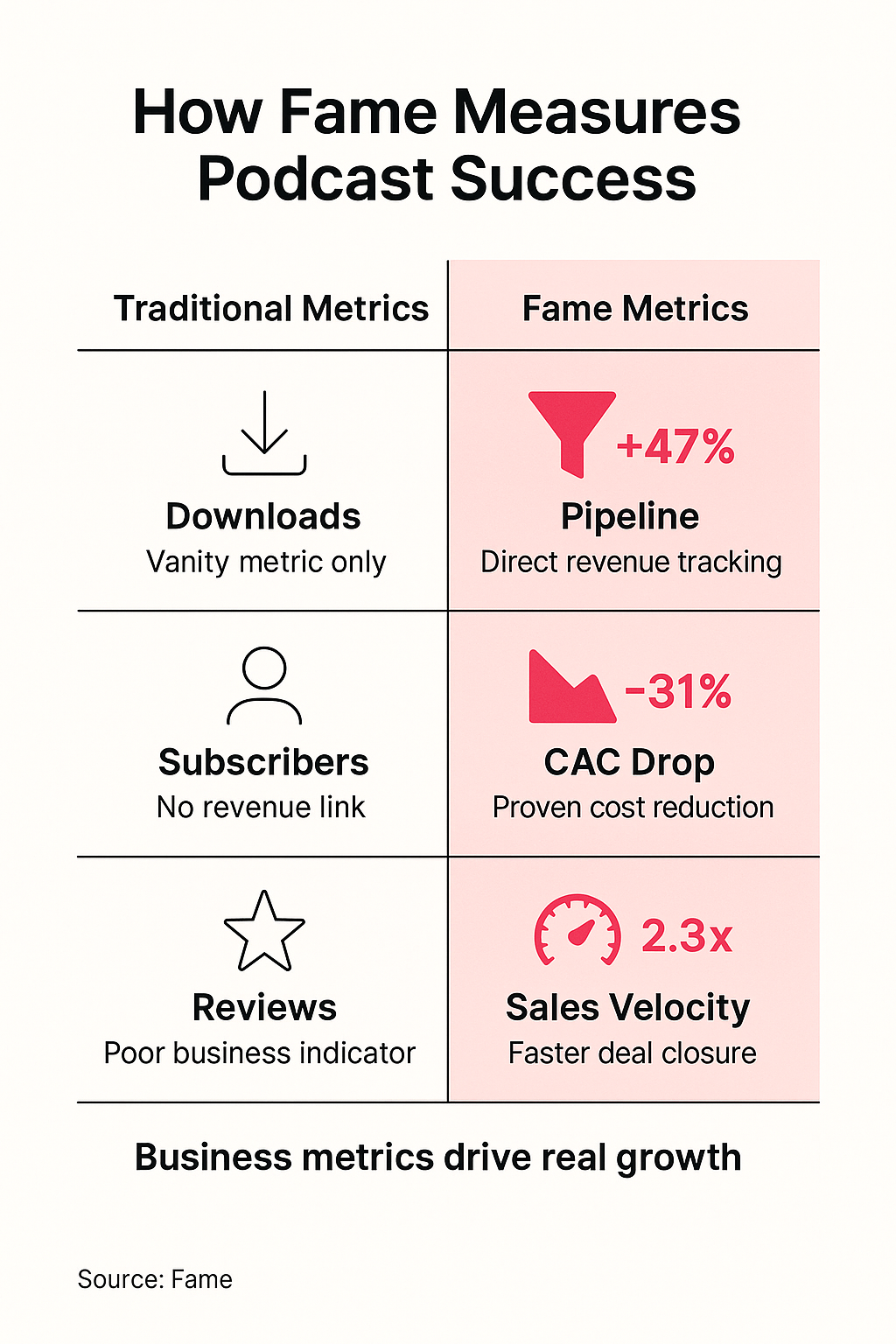
Measurement, Continuous Improvement & Future-Proofing
Key Metrics for B2B Podcast ROI
Stop measuring downloads. Start measuring deals. The most successful B2B podcasting companies track metrics that actually correlate with revenue, not vanity numbers that impress no one but your audio engineer.
Leading indicators tell you if your B2B podcast strategy is working before the pipeline shows up. Track completion rates by segment. When CTOs finish 92% of your episodes while managers drop off at 40%, you've found your real audience. Monitor CRM-attributed leads through UTM parameters on show notes and custom landing pages. One client discovered their podcast drove 3x more qualified leads than webinars by tracking content engagement patterns across their tech stack.
Lagging indicators prove the revenue impact. Pipeline sourced directly from podcast relationships, sales cycle compression for deals with podcast touchpoints, and closed-won revenue influenced by podcast content. A cybersecurity firm using Fame's Revenue Attribution Model traced $1.2M in closed deals back to podcast guest relationships within 18 months. Their average sales cycle dropped from 180 to 120 days when prospects engaged with podcast content before demos.
Implementation starts with connecting your podcast platform to your CRM through native integrations or attribution tools. Map every listener touchpoint, from episode consumption to demo requests. The companies seeing real B2B podcast ROI aren't guessing; they're measuring with the same rigor they apply to paid campaigns.
Analysis Framework: Data-Driven Decision Making
Raw data without analysis is just expensive noise. The B2B podcast winners segment their metrics to uncover patterns that drive strategic decisions, not just quarterly reports.
Start with persona-based segmentation. When you map engagement data to your ICP tiers, patterns emerge. A MarTech company discovered their enterprise segment consumed 4x more content but converted at half the rate of mid-market listeners. They adjusted their guest strategy to feature more mid-market leaders, resulting in a 40% increase in qualified pipeline within one quarter.
Intent and funnel stage segmentation reveals content gaps. Track which episodes drive top-of-funnel discovery versus bottom-funnel conversions. One SaaS platform found their technical deep-dives accelerated deals in final stages while industry trend episodes attracted net-new prospects. This insight transformed their content calendar from random topics to strategic pipeline acceleration.
Decision criteria should center on measurable pipeline impact, not feel-good metrics. If an episode format generates buzz but zero leads, kill it. If a boring technical walkthrough consistently influences deals, double down. The best B2B podcasting companies make content decisions like they make product decisions, based on data, not opinions.
Continuous Improvement: The Fame Optimization Cycle
Podcasts that plateau die slowly. The top 1% of B2B podcasts run systematic optimization cycles that compound gains over time.
Monthly reviews focus on tactical adjustments. Which guest types generated the most engagement? What episode lengths maximize completion rates? A FinTech podcast increased their completion rate from 72% to 89% by cutting episodes from 45 to 28 minutes after monthly data revealed the exact drop-off point.
Quarterly cycles drive strategic pivots. Test new formats, distribution channels, and content themes with enough runway to measure impact. An AI startup experimented with video-first production, saw a 3x increase in LinkedIn engagement, and made it their default format. Another client tested AI-powered content summarization and turned every episode into 15 repurposed assets, multiplying their content ROI without additional production costs.
Success metrics for optimization aren't subjective. Track improvement in completion rates, guest-to-opportunity conversion, content repurposing efficiency, and pipeline velocity. When a legal tech firm implemented quarterly format experiments, they discovered panel discussions generated 2.5x more social shares than interviews, leading to a 35% increase in inbound leads.
Common Pitfalls & How to Avoid Them
Most B2B podcasts die not from lack of effort, but from fundamental strategic misalignment. After analyzing over 100 B2B podcast launches, we've identified three critical failures that separate pipeline-generating shows from expensive vanity projects.
Pitfall 1: Chasing reach over revenue. The biggest mistake in B2B podcast strategy? Obsessing over download counts while ignoring pipeline impact. One SaaS company we audited celebrated 10,000 monthly downloads but couldn't attribute a single qualified lead to their show. The solution: implement pipeline attribution from day one. Build UTM tracking into every CTA, create podcast-specific landing pages, and integrate self-reported attribution into your demo booking forms. When a cybersecurity firm shifted from measuring downloads to tracking influenced pipeline, they discovered their "underperforming" podcast had actually driven $1.2M in opportunities that marketing had previously missed.
Pitfall 2: Audio-only inertia. Sticking to audio-only in 2025 is like running paid ads without retargeting pixels. The solution: go video-first, omnichannel, and optimize for search. Video podcasts generate 38% more engagement and create 12x more repurposable content than audio-only shows. A B2B podcasting company we partnered with saw organic reach jump 340% after implementing video-first production. Every episode becomes fuel for LinkedIn clips, YouTube SEO, and sales enablement materials. The incremental cost? Less than 15% more than audio-only production.
Pitfall 3: Siloed content teams. When podcast production operates in isolation from GTM strategy, you're burning budget on content that never converts. The solution: integrate podcasting with GTM, sales, and CRM workflows from the start. This means sales teams get episode alerts when target accounts appear as guests, marketing automation triggers nurture sequences based on episode topics, and CRM data informs guest selection. A marketing automation platform increased guest-to-opportunity conversion by 4x simply by connecting their podcast workflow to Salesforce.
Reality check: If your podcast isn't tied to pipeline, it's dead weight. Every B2B podcast that survives past year one has one thing in common: clear attribution to revenue. The shows that fail? They're the ones measuring success by metrics that don't appear on P&L statements.
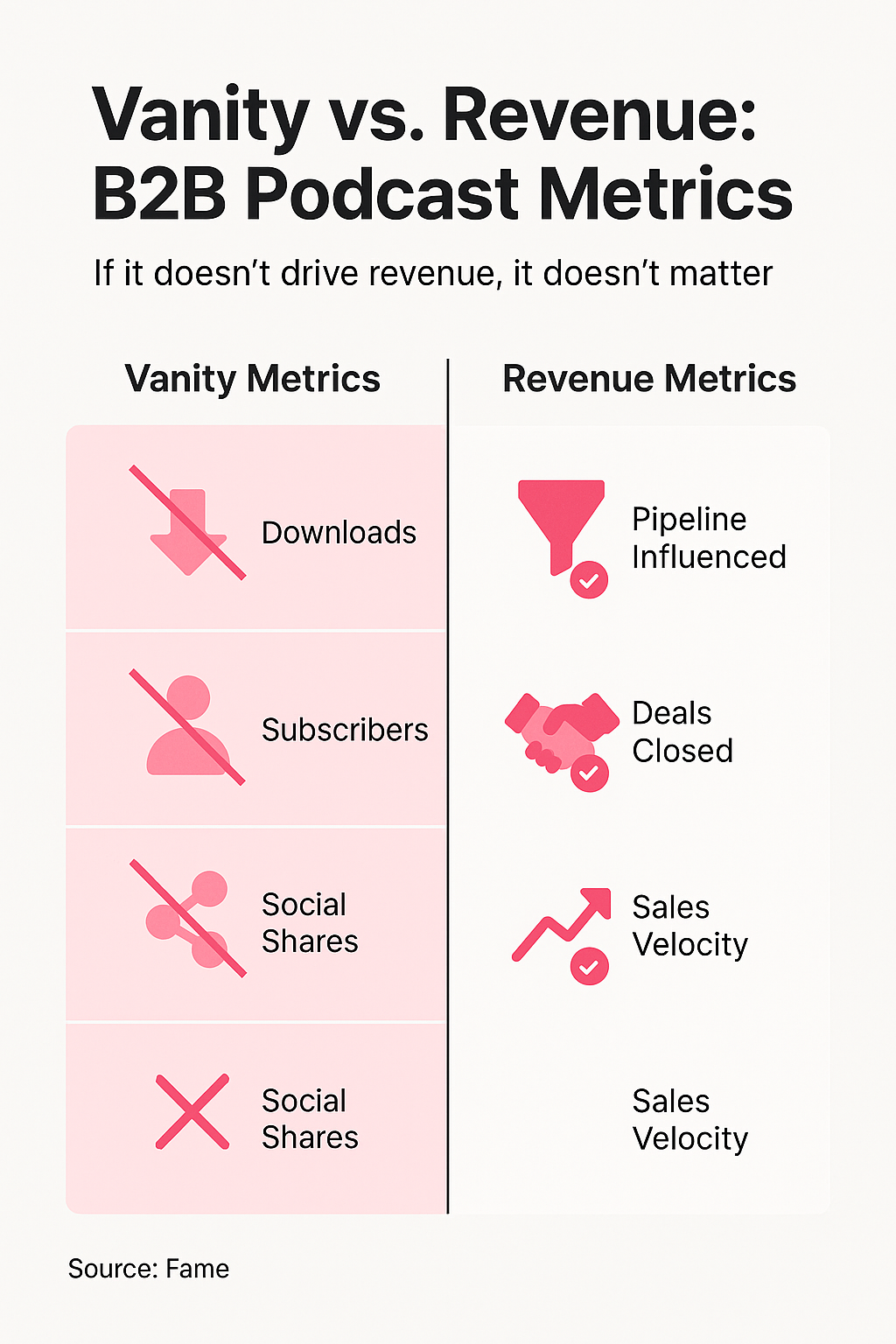
Final Checklist: The 2025 B2B Podcasting Stack
Forget the generic podcast launch guides. This is the exact B2B podcast strategy stack that separates pipeline-generating shows from expensive hobbies. Every element here has been battle-tested by companies that turned podcasts into their most profitable demand-gen channel.
Pre-Launch Requirements:
Category-defining positioning isn't optional; it's your competitive moat. Map your ICP down to the decision-making unit, not just job titles. When a cybersecurity firm narrowed their focus from "IT leaders" to "CISOs at 500+ employee financial services companies managing cloud migrations," their guest acceptance rate jumped from 12% to 47%. Your attribution infrastructure needs to be ready before episode one. That means UTM parameters, dedicated landing pages, and CRM fields that track podcast touchpoints. Without this foundation, you're flying blind.
The video-first, AI-powered production workflow isn't about following trends; it's about content velocity. Companies using AI for editing and repurposing produce 3x more derivative content per episode, extending reach without extending budgets. One B2B podcasting company client generated 47 pieces of content from a single 30-minute interview using AI-driven workflows.
Quality Assurance:
CRM-integrated CTAs transform passive listening into active pipeline. Smart operators embed unique offer codes, exclusive resources, and time-sensitive CTAs that create urgency without feeling pushy. Your omnichannel distribution plan should map content across LinkedIn, YouTube, email, and private feeds; each channel is optimized for specific consumption patterns. A quarterly review process keeps your show sharp. Track guest quality, topic performance, and pipeline attribution to identify what drives results versus what just sounds good.
Success Indicators:
Real B2B podcast ROI shows up in three places: attributed pipeline, accelerated sales velocity, and measurable trust signals from your ICP. If you're not seeing positive ROI within 6-12 months, your strategy needs surgery, not tweaks.
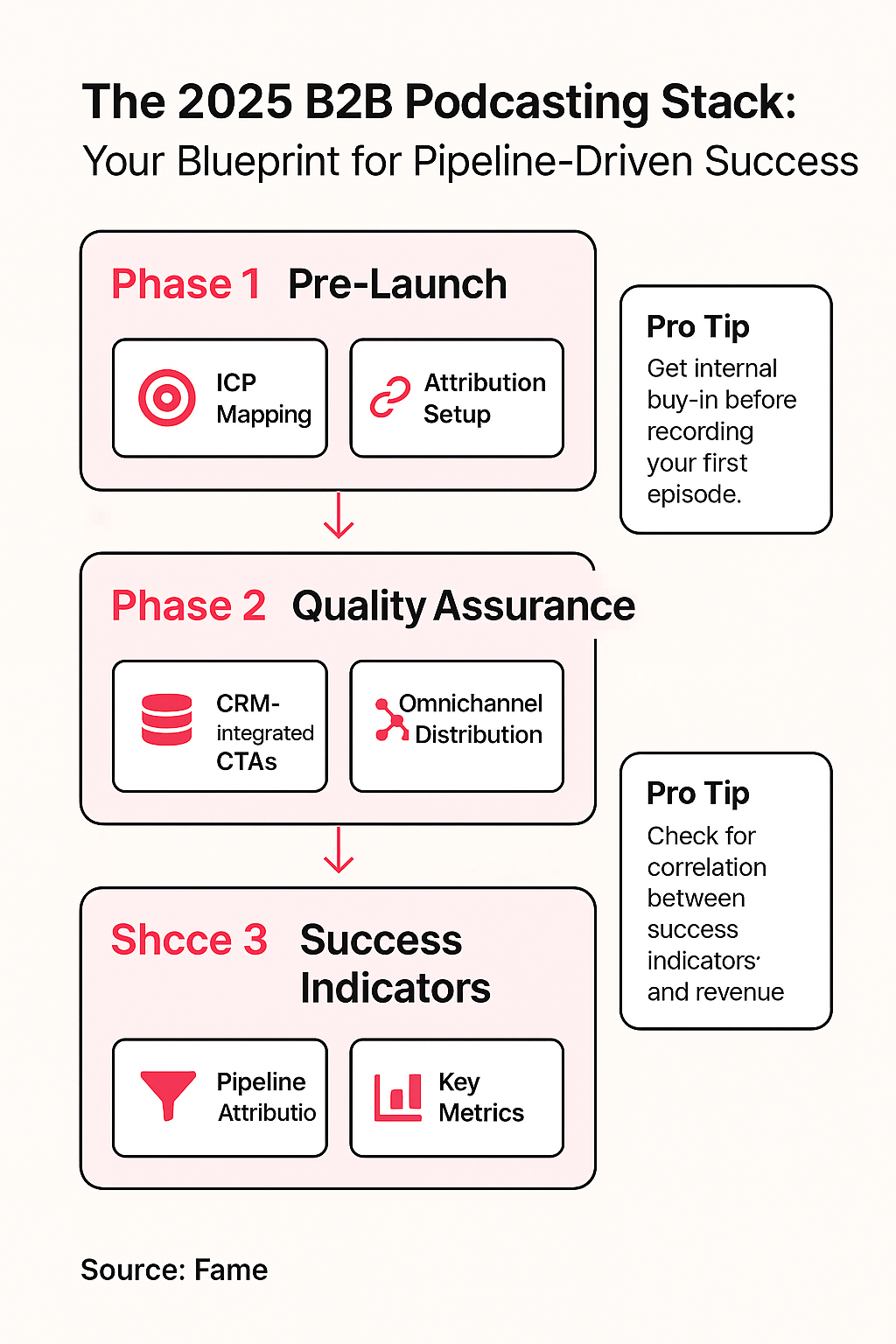
Transform Your Podcast From Cost Center to Revenue Engine
B2B podcasting in 2025 isn't about being heard; it's about being remembered by the people who buy.
The only metric that matters? Pipeline.
The smartest B2B brands have already made the shift. They're building attribution engines disguised as shows, generating $4.2M in pipeline while others count downloads. They're not partnering with just any B2B podcasting company; they're choosing operators who understand that every episode should earn its keep in pipeline impact.
Fame's approach transforms podcasts from vanity projects into revenue drivers. Our Pipeline-to-Podcast Attribution Model, Content Repurposing Matrix, and Strategic Guest Booking Engine turn conversations into contracts. We measure success in closed deals, not social shares.
Ready to build a podcast that compounds value with every episode?
FAQs
How are macro trends in B2B podcasting fundamentally changing demand generation strategies in 2025?
B2B podcasting has shifted from vanity metrics to pipeline accountability, 50% of marketers are increasing podcast investment, and top-performing shows now attribute revenue with the same rigor as paid channels. Podcasts are no longer just brand plays; they're integrated into CRM workflows, driving $1M+ in pipeline for operators who treat them as core revenue channels, not content experiments.
What's the real business case for going video-first and embracing multimedia podcasting?
Video-first podcasts generate 3x more repurposable assets and 5x higher engagement on platforms like LinkedIn and YouTube, turning each episode into a week's worth of pipeline-driving content. Companies that pivoted to video saw pipeline double and organic reach jump 340%, proving that audio-only is dead weight in a demand-gen world.
How does AI and automation actually impact podcast ROI and operational efficiency?
AI-powered production slashes editing time by 70% and enables real-time attribution, while automated lead scoring cuts podcast-to-pipeline time from 90 to 30 days. The winners aren't just saving costs, they're reinvesting in smarter distribution and guest acquisition, consistently seeing 34% pipeline lifts from advanced attribution investments.
What shifts in audience behavior should executives exploit to maximize pipeline from podcasting?
80% of B2B podcast audiences listen to most or all of each episode, meaning you have 20-50 minutes of undivided attention from budget owners. Structuring episodes around buying stages and embedding CRM-integrated CTAs has boosted listener-to-MQL conversion rates from 0.8% to 4.2% in just four months for leading operators.
How should demand-gen teams measure podcast success and prove ROI to the C-suite?
Ditch downloads, track pipeline influenced, demo requests within 30 days, guest-to-opportunity conversion, and content repurposing velocity (10-15 assets per episode is the benchmark). Fame clients have traced $4.2M in attributed pipeline and 67% lower CPL compared to paid channels, with initial pipeline signals visible in 45 days and full attribution clarity by 90.
What are the most common pitfalls in B2B podcasting, and how do we avoid them?
Chasing reach over revenue, sticking to audio-only, and running podcasts in silos kill ROI, shows that fail to integrate attribution, video, and GTM alignment become expensive hobbies. The fix: build attribution into your stack from day one, go video-first for omnichannel reach, and connect podcasting directly to sales and CRM workflows.
What are the first steps to future-proof our B2B podcast strategy and drive measurable business impact?
Start with a pre-launch audit: map attribution gaps, assess video readiness, and identify repurposing opportunities. Implement CRM-integrated CTAs, launch video on YouTube, and set up self-reported attribution fields, expect to see pipeline movement within 45 days. If your podcast isn't driving revenue in 6-12 months, it's time for a strategic overhaul, not minor tweaks.

